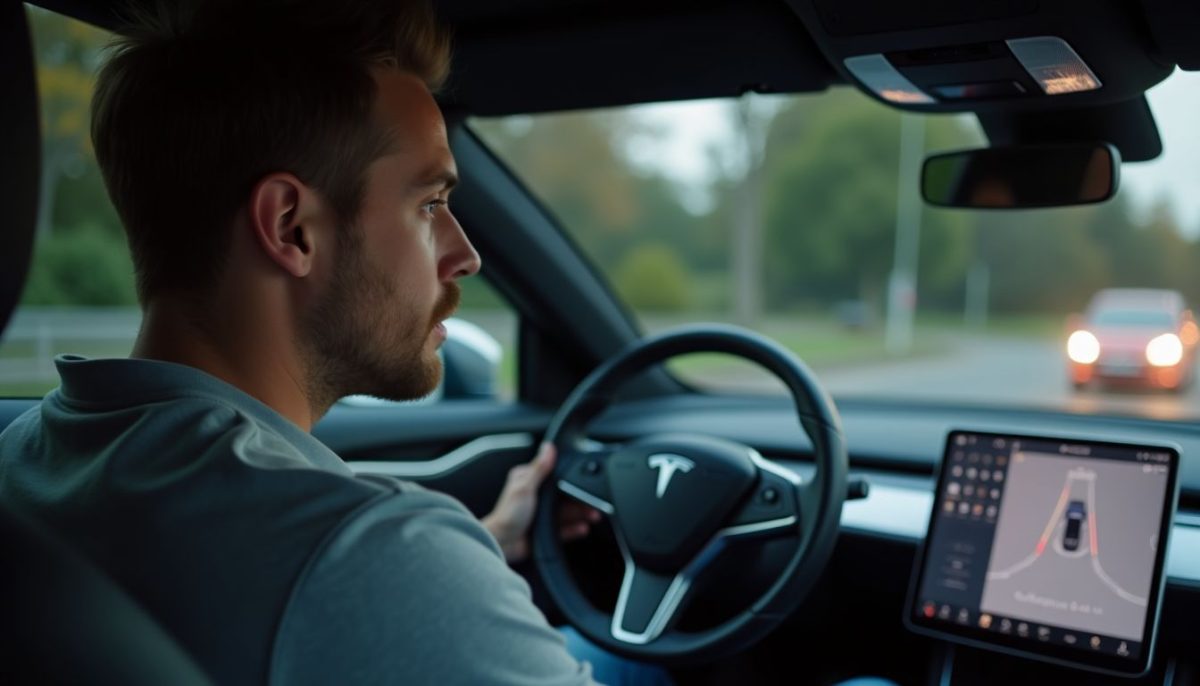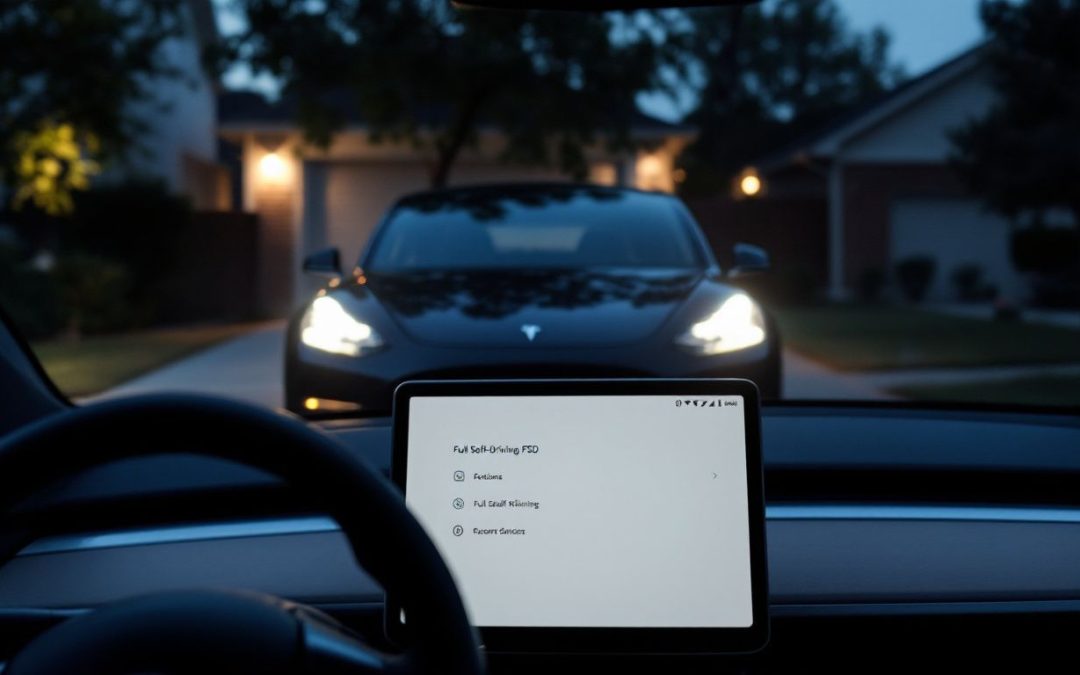If you drive a Tesla Model S, Model 3, Model X, or Model Y, you might wonder if Tesla Fsd is worth the upgrade. Tesla now offers a 30-day free trial of its Full Self-Driving software.
This article reviews Fsd’s features and benefits to help you make an informed choice. Discover if Fsd suits your Tesla needs.
Key Takeaways
- Free Trial Available: Tesla offers a 30-day free trial for Full Self-Driving (FSD) software.
- Advanced Features: FSD includes Autosteer, Navigate on Autopilot, and Autopark to make driving easier.
- Safety Enhancements: FSD has automatic emergency braking and blind spot monitoring but is linked to some fatal accidents.
- Ongoing Investigations: The NHTSA is investigating 2.4 million Tesla vehicles for FSD-related safety issues.
- Latest Updates: FSD version 12.5 adds Actually Smart Summon and sunglasses support for better driving convenience.
Overview of Tesla’s Full Self-Driving (FSD) Capabilities

Tesla’s Full Self-Driving (FSD) uses Autopilot and Autosteer to manage the car on the road. The system includes collision warnings and can automatically park your Tesla.
Current features and functionality
Tesla FSD offers features like Autosteer, Navigate on Autopilot, and Autopark. The Tesla app lets drivers control these functions easily. New vision-based driver monitoring ensures drivers stay attentive.
Cybercab and Robovan showcase Tesla’s autonomous vehicle designs without steering wheels. Over-the-air software updates keep the system current. Models S, X, 3, Y, and the Cybertruck are under NHTSA investigation for traffic safety.
Lambert reported FSD v12.5 improves driving comfort and auto speed mode.
“FSD continues to evolve, making Tesla vehicles smarter and safer on the road.”
Recent updates and enhancements
FSD version 12.5.4.1 introduces Actually Smart Summon and sunglasses support. These features improve Tesla’s driver assistance system, enabling hands-free driving. In March, Tesla began offering the first free FSD trials.
After releasing FSD version 12, mandatory test drives became required. Fred Lambert received FSD v12.5.2.1 for his Model 3 and experienced two disengagements during his test.
Mark Yates highlighted that HW3 cameras have lower resolution compared to HW4, affecting Tesla vision. Despite these enhancements, driver attentiveness remains crucial for safety and preventing collisions.
The updates show Tesla’s commitment to advancing its autopilot software, but users must stay alert while using the full self-driving features.
The Value Proposition of Upgrading to FSD
Upgrading to Tesla’s Full Self-Driving (FSD) boosts safety with features like automatic emergency braking and blind spot monitoring. It also enhances driving ease through advanced driver assistance systems, including traffic-aware cruise control and automated parking.
Safety improvements
Tesla’s Full Self-Driving (FSD) includes features like automatic emergency braking and forward collision warning. These advanced driver assistance systems help reduce crashes and enhance vehicle safety.
In April 2023, a Tesla Model Y was involved in a fatal accident near Seattle. Later, in November 2023, another fatal crash occurred in Rimrock, Arizona. The National Highway Traffic Safety Administration (NHTSA) is investigating 2.4 million Tesla vehicles for FSD-related accidents.
The probe focuses on how FSD detects obstacles in low-visibility conditions like sun glare and fog. Critics say Tesla’s camera-only system may struggle without lidar and radar sensors.
Ensuring the safety of autonomous driving systems is paramount to protecting lives on the road.
Enhanced driving convenience
FSD version 12.5.4.1 boosts driving convenience with new features. Actually Smart Summon (ASS) lets cars park and retrieve themselves. Sunglasses support allows hands-free driving in bright conditions.
Vision-based driver monitoring alerts drivers if they’re not looking at the road. In March, Tesla offered free FSD transfers for new purchases, continuing into Q4. Lambert highlighted better driving comfort and auto speed mode.
These updates enhance Tesla’s autopilot and driver-assistance systems, making trips smoother for Model 3 and Model Y owners.
Enhanced Autopilot works seamlessly with full self-driving capabilities. Drivers enjoy easier parallel parking and handling interchanges. Auto speed mode adjusts to traffic, reducing driver effort.
Tesla focuses on convenience with improved turn signals and automatic stop sign recognition. These advancements support Tesla’s goal for practical self-driving vehicles, appealing to car enthusiasts who seek the latest technology in their cars.
The Future of Autonomous Vehicles and Tesla’s Role
Tesla will advance its Full Self-Driving system by launching robotaxis in major cities. These self-driving cars will provide safer and more convenient travel for everyone.
Tesla’s roadmap for FSD advancements
Tesla plans to advance FSD with version 12.5.4.1, adding Actually Smart Summon and sunglasses support for hands-free driving. In March, the first free FSD trials began, and after version 12, mandatory test drives will start.
In December, over two million U.S. vehicles were recalled to improve Autopilot safety. October 2023 saw Tesla face Justice Department subpoenas related to FSD and Autopilot investigations.
Lambert noted that FSD v12.5 has better features but safety risks still exist. These updates show Tesla’s focus on enhancing driverless vehicles and automotive safety.
Conclusion
Upgrading to Tesla’s Full Self-Driving can boost safety and make driving easier. You can try it free for 30 days with features like Smart Summon. But, there are concerns as the NHTSA investigates 2.4 million Teslas after some accidents.
Two deaths have been linked to FSD, raising safety questions. Think about these points to decide if the upgrade fits your needs.
FAQs
1. What does Tesla Full Self-Driving include?
Tesla Full Self-Driving (FSD) offers features like navigating traffic lights, stop signs, and parking spaces. It uses ADAS and engineering controls to enhance auto safety. FSD works with Tesla Model 3, Model Y, and other models.
2. Is Tesla FSD safe to use?
Yes, FSD includes safety features such as hazard lights and automatic headlights. It relies on Tesla’s Autopilot and supervised driving to ensure safe operation. Human oversight from the owner’s manual is still needed.
3. How does FSD handle traffic and road situations?
FSD can manage traffic lights, stop signs, and navigate off-ramps. It uses blinkers and the accelerator pedal to control the car smoothly. This helps in predicting and responding to traffic conditions effectively.
4. Can I use FSD with other Tesla products?
Yes, FSD works well with Tesla’s supercharger network and can integrate with powerwall for energy needs. It also supports vehicles like the Roadster and can be used alongside Megapack for larger energy storage.
5. Does upgrading to FSD affect federal tax credits?
Upgrading to FSD may influence eligibility for federal tax credits. It’s important to check current regulations and how they apply to your Tesla Model 3, Model Y, or other models in your region, including the European Union.
6. How does FSD compare to other systems like GM’s?
Tesla FSD offers advanced features such as full self-driving capabilities, whereas GM’s systems may have different levels of autonomy. Elon Musk continues to improve FSD with updates, making it a strong option for those seeking comprehensive driving assistance.

